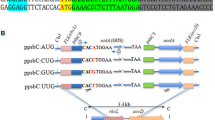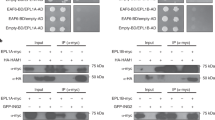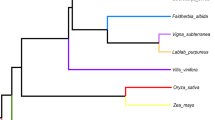Abstract
THERE is now growing experimental support for the hypothesis that nucleoprotein genetic determinants located outside the nucleus confer photosynthetic activity on plastids. The first clear indication of nucleoprotein involvement in plastid mutation was derived from the action spectrum for ultra-violet inactivation of Euglena plastids which showed peaks at 260 and 280 mµ1. This ultra-violet sensitive plastid determinant is photoreactivable2, and evidence for its cytoplasmic nature has been reported1–3. Comparison of wild-type and ultra-violet-induced mutants of Euglena strongly suggests that a DNA of different base composition from the nucleus is uniquely associated with the ability to form plastids4. Similar findings have been reported for plastids of other algae4–8 and higher plants6,9. The recent observation10 that cells which incorporate azathymine in place of thymine exhibit increased resistance to ultra-violet inactivation of plastids is consistent with the reports that plastids have associated with them a specific DNA, and serves as a guide to the rational search for chemical agents that might be expected to induce plastid mutations. By analogy with other nucleoprotein genetic systems, we have postulated that incorporation of base analogues into the genetic material that determines plastids should lead to mutational changes, and that such changes would be reflected in altered plastid structure and function. This communication presents evidence for incorporation of 5-bromouracil into cells of Euglena gracilis, and describes conditions for obtaining stable colourless plastid mutants during replication of plastid determinants in the presence of 5-bromouracil and sulphanilamide.
This is a preview of subscription content, access via your institution
Access options
Subscribe to this journal
Receive 51 print issues and online access
$199.00 per year
only $3.90 per issue
Buy this article
- Purchase on SpringerLink
- Instant access to full article PDF
Prices may be subject to local taxes which are calculated during checkout
Similar content being viewed by others
References
Lyman, H., Epstein, H. T., and Schiff, J. A., Biochim. Biophys. Acta, 50, 301 (1961).
Schiff, J. A., Lyman, H., and Epstein, H. T., Biochim. Biophys. Acta, 50, 310 (1961).
Gibor, A., and Granick, S., J. Cell Biol., 15, 599 (1962).
Leff, J., Mandel, M., Epstein, H. T., and Schiff, J. A., Biochem. Biophys. Res. Comm., 13, 126 (1963).
Sager, R., and Ishida, M. R., Proc. U.S. Nat. Acad. Sci., 50, 725 (1963).
Chun, E. H. L., Vaughn, M. H., and Rich, A., J. Mol. Biol., 7, 130 (1963).
Baltus, E., and Brachet, J., Biochim. Biophys. Acta, 76, 490 (1963).
Gibor, A., and Izawa, M., Proc. U.S. Nat. Acad. Sci., 50, 1164 (1963).
Kirk, J. T. O., Biochim. Biophys. Acta, 76, 417 (1963).
Lyman, H., and Smillie, R. M., Plant Physiol., 88, Suppl. III (1963).
Hutner, S. H., Bach, M. K., and Ross, G. I., J. Protozool., 3, 101 (1956).
Freese, E., J. Mol. Biol., 1, 87 (1959).
Litman, R. M., and Pardee, A. B., Biochim. Biophys. Acta, 42, 131 (1960).
Author information
Authors and Affiliations
Rights and permissions
About this article
Cite this article
SCHER, S., COLLINGE, J. Chloroplast Replication : Evidence for 5-Bromouracil Incorporation and Plastid Mutation in Euglena gracilis. Nature 205, 828–830 (1965). https://doi.org/10.1038/205828b0
Issue date:
DOI: https://doi.org/10.1038/205828b0



